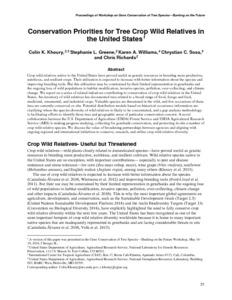Conservation Priorities for Tree Crop Wild Relatives in the United States
Crop wild relatives native to the United States have proved useful as genetic resources in breeding more productive, nutritious, and resilient crops. Their utilization is expected to increase with better information about the species and improving breeding tools. But this utilization may be constrained by their limited representation in genebanks and the ongoing loss of wild populations to habitat modification, invasive species, pollution, over-collecting, and climate change. We report on a series of related initiatives contributing to conservation of crop wild relatives in the United States. An inventory of wild relatives has documented taxa related to a broad range of food, forage and feed, medicinal, ornamental, and industrial crops. Valuable species are threatened in the wild, and few accessions of these taxa are currently conserved ex situ. Potential distribution models based on historical occurrence information are clarifying where the species diversity of wild relatives is likely to be concentrated, and a gap analysis methodology is facilitating efforts to identify those taxa and geographic areas of particular conservation concern. A novel collaboration between the U.S. Department of Agriculture (USDA) Forest Service and USDA Agricultural Research Service (ARS) is making progress studying, collecting for genebank conservation, and protecting in situ a number of crop wild relative species. We discuss the value of broadening partnerships between agencies and aligning with ongoing regional and international initiatives to conserve, research, and utilize crop wild relative diversity.

